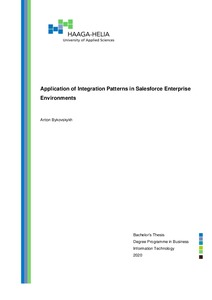Application of Integration Patterns in Salesforce Enterprise Environments
Bykovskykh, Anton (2020)
Bykovskykh, Anton
2020
All rights reserved. This publication is copyrighted. You may download, display and print it for Your own personal use. Commercial use is prohibited.
Julkaisun pysyvä osoite on
https://urn.fi/URN:NBN:fi:amk-2020052714366
https://urn.fi/URN:NBN:fi:amk-2020052714366
Tiivistelmä
With a growth of technologies, data and the need of sharing and analysing the data became increasingly important. Enterprise companies require a reliable way of moving the data between different systems. There are many out-of-the-box products which provide integration solutions. However, not in all cases such products justify the price or fulfil the requirements. That is the time when custom integrations have to be built.
The goal of this thesis is to improve the development approach of custom integrations in Salesforce environment. This goal is achieved by implementing the solution for custom integrations based on the customer requirements, analyzing the result and implementing the enhancements to the solution, to provide a more reliable, scalable and easily maintainable solution.
Basics of the Salesforce environment are explored in the theoretical part. Moreover, essential parts of integrations, APIs and Salesforce integration patterns are explained in the theoretical framework chapter.
Implementation of the project and following enhancements aims to provide a solution, which utilizing the best development practices and enhancing all future integrations implementations. Project aim to solve the real world problem and bring benefit to a specific group of people who are working with Salesforce integration patterns solutions.
The goal of this thesis is to improve the development approach of custom integrations in Salesforce environment. This goal is achieved by implementing the solution for custom integrations based on the customer requirements, analyzing the result and implementing the enhancements to the solution, to provide a more reliable, scalable and easily maintainable solution.
Basics of the Salesforce environment are explored in the theoretical part. Moreover, essential parts of integrations, APIs and Salesforce integration patterns are explained in the theoretical framework chapter.
Implementation of the project and following enhancements aims to provide a solution, which utilizing the best development practices and enhancing all future integrations implementations. Project aim to solve the real world problem and bring benefit to a specific group of people who are working with Salesforce integration patterns solutions.
